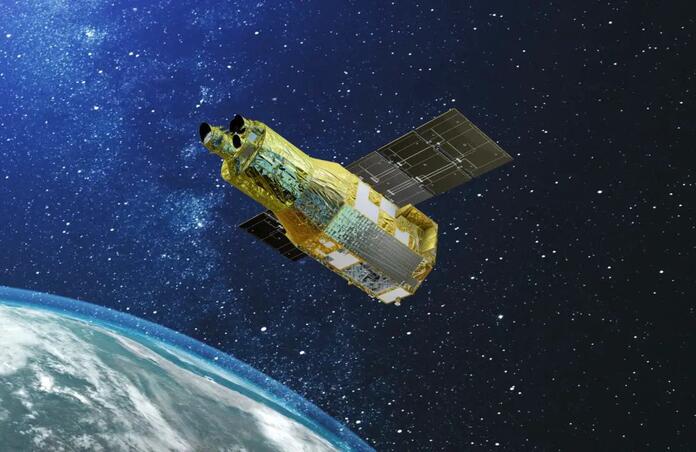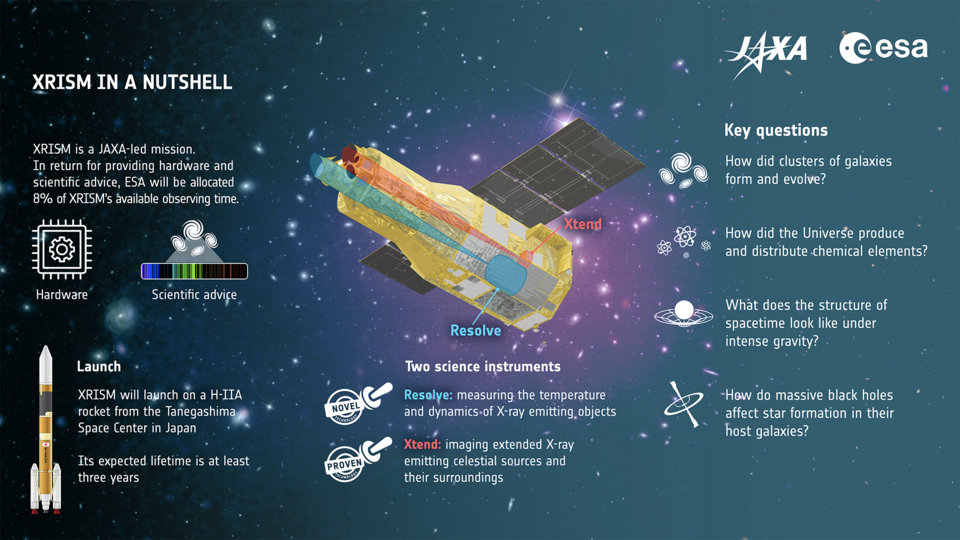the XRISM mission - viewing the universe with x-ray vision

Japan Aerospace Exploration Agency is planning to launch the X-ray Imaging and Spectroscopy Mission (XRISM) in a collaboration with NASA and significant participation from ESA. The mission will aim to provide insight into the evolution of the universe and help to answer many ongoing questions in the world of astrophysics, such as how the universe produced and distributed elements, what the structure of space-time looks like under the pull of gravity and how massive black holes affect star formation in their host galaxies.

The universe is brimming with hot gas which emits X-rays. However, these wavelengths are outside of the visible spectrum, so cannot be seen with the naked eye or ground-based telescopes. Such rays hold vital information about the formation and evolution of the universe, so observing at these wavelengths is essential to develop our understanding. X-rays are typically released in some of the biggest explosions and most energetic phenomena in the universe. An example is supermassive black holes. Matter is dragged inwards towards the centre of the black hole, forming an accretion disk and ejecting jets of X-rays travelling near to the speed of light. By observing these jets, XRISM will be able to determine the velocity and energy radiating from the accreted and ejected gas.
Another source of X-rays is hot gas that clusters in between galaxies – the intracluster medium. This gas can reach scalding temperatures of tens of millions of degrees, revealing clues about the evolution of the universe’s chemistry. This is because the composition of the intracluster medium is determined based on the explosions of massive dying stars and the subsequent birth of new ones.
Unlike classic telescope mirrors, XRISM uses X-ray Mirror Assemblies (XMA). These are a cylindrical construction of thin aluminium foils placed one inside the other, and each XMA comprises 1624 segments. The two mirrors reflect X-rays into a sensor on the spacecraft found 5.6m away.
XRISM is equipped with two instruments, the first being a spectrometer named Resolve. Part of a collaboration between JAXA and NASA, Resolve measures minute changes in temperature when an incoming x-ray photon encounters its 6x6 pixel detector. To take such measurements, the instrument must be kept 50x cooler than deep space using a mechanical cooling process that takes place inside a fridge-sized container filled with liquid helium. These temperature changes can be converted into light intensity over different ranges of energy between 400 and 12,000 electron volts. To put this into perspective, Resolve measures energies that are hundreds to thousands of times larger than visible light, which has energies of just a few electron volts.
The spectrometer will be accompanied by another instrument named Xtend. This will allow XRISM to image X-ray sources with a larger field of view than any previous X-ray imaging satellite to date, observing over an area around 60% larger than the apparent size of the full moon. The instrument will monitor nearby stars that emit variable X-rays as well as map the properties of background X-ray sources.
“XRISM will be a valuable bridge between ESA’s other X-ray missions: XMM-Newton, which is still going strong after 24 years in space, and Athena, which is due to launch in the late 2030s,” said Matteo Guainazzi, ESA’s project scientist for XRISM in a statement.
JAXA's Smart Lander for Investigating the Moon (SLIM) will also be a passenger on board the H-IIA Launch Vehicle No.47 with XRISM, situated in Tanegashima Space Center, Japan. Following the launch, XRISM will begin a months-long calibration phase, where Resolve will reach its operating temperature.
--
Cover image: JAXA
